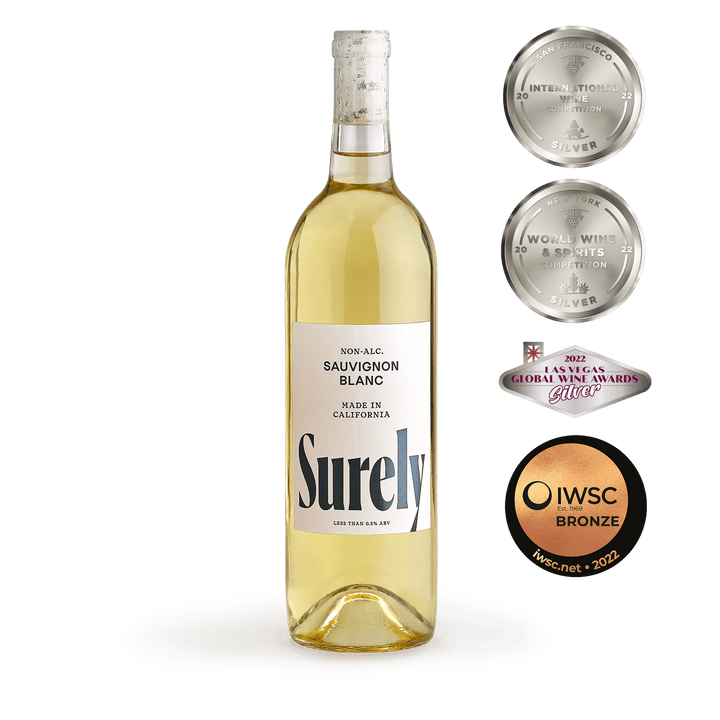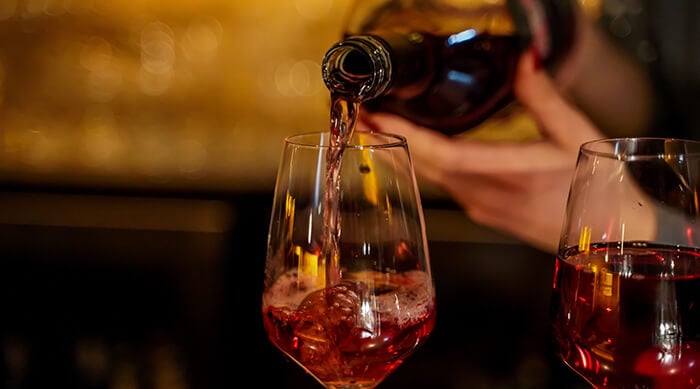Drinking wine and sticking to a low-sugar diet are not mutually exclusive. You just need to be smart about the varietals you choose to stick to your plan, whether that’s low-carb, keto, the Paleo diet, or even diabetes management.
The good news is, it’s easier than ever to find essentially sugar-free wine options at wine shops or online today.
What are the benefits of drinking sugar-free wine? The benefits of drinking sugar-free wine center around your health. Anyone watching their sugar due to chronic conditions, weight management, or a diet plan should consider the sugar content in wine.
Low-sugar wines are usually low-carb wines and lower in calories, making them a better option for anyone watching their calories.
Table of Contents
What Exactly is Sugar-Free Wine?
What is the Sugar Content in Wine?
Considerations For Keto & Low Carb Dieters
Types of Wine With the Most Sugar
What Exactly is Sugar-Free Wine?
Sugar-free wine is wine without added sugars. Zero-sugar wine may have sugar levels that aren’t significant enough to warrant a mention on the label.
If you drink wine, though, you will interact with some sugar, whether you like it or not. You just can’t have a conventional wine without sugar, even if you were to make the wine yourself.
First, grapes contain naturally occurring sugars like fructose and glucose. After those grapes are crushed — or stomped, if you’re old school — winemakers add yeast to those sugars to kick off the fermentation process.
Yeast breaks down the sugar and turns it into alcohol and carbon dioxide. A longer fermentation means a higher alcohol content. Any residual sugar left behind after the yeast has snacked on those sugars is what determines the sugar content of that wine.
That said, winemakers play a big part in how much sugar is in the final product.
Many brands that market themselves as low-calorie or no-to-low sugar, such as Skinnygirl, avoid adding sugar to their final product. Natural wines or organic brands tend to avoid other additives, as well.
Some brands use additional sugar to sweeten their wines, adjust aromas, or tweak the alcohol by volume (ABV) in their bottles. These are usually lower-quality wines.
Sugar-Free Wine and Hangovers
Drinking less (or not drinking at all) is the only way to ensure you won’t wake up with a hangover the following day. If you know you’re already sensitive to sugar, a super sweet dessert wine won’t do you any favors.
Consuming too much sugar in one sitting can cause changes in blood sugar levels for many and wine headaches in some. That can make hangovers even worse the next day as your body tries to manage those changes.
Drinking too much also puts you at risk for dehydration, a known cause of headaches. Pair that with too much sugar, and many end up feeling the effects of sweet wines more acutely than dry, low-sugar wines.
What is the Sugar Content in Wine?
The sugar content in many dry red and white wines is about 1 gram per serving. That’s just a single gram of sugar in a 5-ounce pour, the standard serving size for most red and white wines.
The sugar in wine varies depending on whether you’re sipping on a dry or sweet wine, but most conventional wines don’t have that much residual sugar.
Lower alcohol wines tend to have more sugar than high-alcohol wines due to what happens to sugar the longer wine is allowed to ferment. It’s not always the case, though. Fortified wines are high in alcohol content and sugar thanks to added spirits, like brandy.
What is the best wine to drink if you're diabetic? The best wine to drink if you’re diabetic is a low-sugar dry red wine, like pinot noir. It’s always best to check with your primary care physician to ensure it’s safe before doing so.
Diabetics tend to see better results in the long-term if they drink a very moderate amount of low-sugar, dark wine. This connection between diabetes and alcoholic drinks is surprising, but supported by a decent amount of research.
That said, alcohol in moderation is vital for any health concerns. The modest benefits of wine aren’t a good reason to start drinking vino if you aren’t already.
Considerations For Keto & Low Carb Dieters
Sugars are carbohydrates. If you’re on the keto diet or watching the carbs in your wine, it can be hard to figure out how much wine it’ll take to break your diet. For most, a dry glass of wine is fine if you’re following keto.
Pay attention to the type of wine you’re drinking and serving sizes. Avoid added sugars, sweet wines, and heavy pours.
Does sugar-free wine have carbs? Sugar-free wine does not have carbs in an amount that would impact your blood sugar or state of ketosis.
Most conventional red and white wines have about 3-4 net carbs per serving. Some bone-dry rosé and sparkling wines like prosecco only have 2 net carbs per serving.
Those carb totals don’t mean drinking conventional wines will make you gain weight. It’s all about moderation. The more you drink, the more empty calories you consume. It can also be harder for you to say no to fatty foods if you’ve had one too many.
Types of Wine With the Most Sugar
Avoid fortified, sweet, and dessert wines if you want to skip extra sugar in your glass.
The sugar in a rosé wine depends on the grapes used in that varietal. A grenache rosé may only have a single gram of sugar, while a bubbly white zinfandel can push the limit to around 4 grams per serving.
These wines tend to contain the most sugar per serving:
- Pink Moscato: 7 g
- Sauternes: 10 g
- Port: 11-12 g
- Ice wine: 12 g
- Late-harvest wines: 12-15 g
Late-harvest wines are made from grapes that lingered on the vine. The result is a sweeter, more concentrated grape and a sweeter wine.
Types of Wine With the Least Sugar
Wines with the least amount of sugar are dry white and red wines. Dry sparkling wines like extra brut champagne are also low-sugar.
Here are some more varietals to consider if you’re watching your sugar intake, with the approximate grams of sugar per glass.
Low-sugar red wines
The healthiest wine — outside of non-alcoholic wine — is high-quality pinot noir due to its high antioxidant activity and low sugar content. Dry red wines are typically acceptable in moderation for keto dieters and others who are watching their sugars.
Low-sugar red wines include:
- Pinot noir: 1 g
- Cabernet sauvignon: 1 g
- Merlot: 1 g
- Malbec: 1-2 g
- Red zinfandel: 1-2 g
- Syrah: 1-2 g
Low-sugar white wines
Low-sugar white wines are dry varietals. While you won’t get the resveratrol boost from the red wines above, a glass of these low-sugar options won’t hurt your chances of hitting ketosis.
Low-sugar white wines include:
- Chardonnay: 1 g
- Chenin blanc: 1 g
- Dry riesling: 1 g
- Pinot grigio: 1 g
- Sauvignon blanc: 1 g
- Viognier: 1 g
Non-Alcoholic Sauvignon Blanc

$22.99
Award-winning alcohol-removed California Sauvignon Blanc. Citrus meets pear and apple to create a crisp, bright, dry sip. TASTING NOTES: This perfectly balanced, dry Sauvignon Blanc is citrus-forward with soft pear and sweet apple notes. FOOD PAIRINGS: The perfect companion to… Read More
If you’re unsure whether your drink is dry or sweet, your taste buds can help. Dry wines are usually big on tannins, which can leave an astringency or bitterness on the tongue. A wine with high acidity is likely low on sugar, too.
If you’re sipping on something that tastes like candy, it’s likely a sweet dessert wine high in sugar.
Is Sugar the Only Concern?
Sugar and wine carbs aren’t the only concerns wine drinkers have when they’re scouring wine labels. Let’s take a look at other things that you might find in a glass of wine and whether you should worry about them:
- Animal proteins: Wine drinkers looking for vegan wines have more than the grapes to worry about when choosing a bottle. Some brands use animal proteins as fining agents to remove debris, sediment, and extra tannins from their wines.
- Gluten: Generally, wine is safe for those who follow a gluten-free diet. If you’re super sensitive, some brands do certify as gluten-free to ensure you are not exposed to trace amounts from cross-contamination or fining agents.
- Sulfites: True sulfite allergies are rare, but wines lower in sugar are typically lower in sulfites and other preservatives. If you think sulfites cause your headaches, avoid natural sulfites, too. Foods like lettuce and garlic are off the table.
- Mycotoxins: We’ve spent all this time discussing dry red wine, so let’s take it down a notch. Researchers have found fungal toxins in dry red wines, especially organic styles. More research is needed to determine whether this poses a severe risk to wine drinkers.
The alcohol in wine is essential to consider, too. Any health benefits of wine come from moderate drinking habits. That translates to just a standard serving size per day for women and 2 glasses of wine per day for men.
Drink more than that, and you’re more likely to experience the harmful effects of alcohol consumption: weight gain, hangovers, and various health conditions.
Low-Sugar, Non-Alcoholic Wine, Delivered.
If you’re not feeling great after drinking wine, it may not be sugar’s fault at all. It could be the alcohol.
No matter how much kudos wine gets for some of its health effects, non-alcoholic wine is always the healthier option. Try our dealcoholized pinot noir if you want a low-calorie option with the antioxidant boosts of red wine. It is smooth, berry-forward, and just 50 calories in an 8-ounce glass.
We hear you on the sugar, too. Our non-alcoholic brut is zero-sugar and all bubbles. Thinking pink? Try our non-alcoholic sparkling rosé with just 1 gram of sugar.
You can have your wine and drink it, too – with Surely.
Sources
- Glucose-Related Traits and Risk of Migraine—A Potential Mechanism and Treatment Consideration
- Dietary Nutrient Intake, Alcohol Metabolism, and Hangover Severity
- Wine Fining with Plant Proteins
- Mycotoxins in red wine: Occurrence and risk assessment
- Contribution of Red Wine Consumption to Human Health Protection
- The positive and negative health effects of alcohol- and the public health implications

![Sugar-Free Wine Benefits [Low Carb & Keto Considerations]](https://dropinblog.net/cdn-cgi/image/fit=scale-down,width=700/34240221/files/featured/sugar-free-wine.jpg)
![Top Organic Wines [Health Facts and Recommendations]](https://dropinblog.net/cdn-cgi/image/fit=scale-down,width=700/34240221/files/featured/organic-wine.jpg)
![How to Cure the Wine Flu [And Avoid a Hangover Next Time]](https://dropinblog.net/cdn-cgi/image/fit=scale-down,width=700/34240221/files/featured/wine-flu.jpg)
